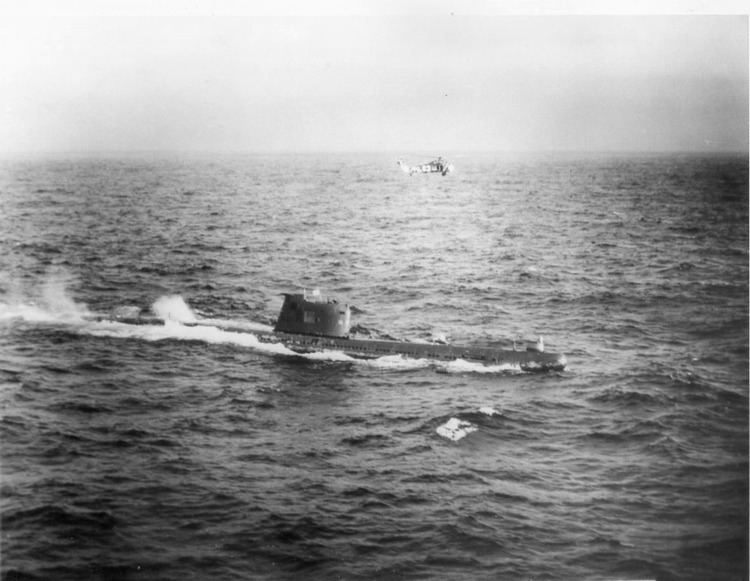Name B-59 Length 91 m Builder Sudomech | Complement 70 Beam 7.5 m | |
 | ||
Displacement 1,957 long tons (1,988 t) surfaced;2,475 long tons (2,515 t) submerged Propulsion Three 2,000 hp (1,500 kW) diesel engines; three 2,700 hp (2,000 kW) electric motors; three shafts Speed 16.8 knots (19.3 mph; 31.1 km/h) surfaced; 16 knots (18 mph; 30 km/h) submerged Range 17,900 nmi (33,200 km) at 8 kn (9.2 mph; 15 km/h) surfaced;400 nmi (740 km) at 2 kn (2.3 mph; 3.7 km/h) submerged | ||
Soviet submarine B-59 (Russian: Б-59) was a Project 641 or Foxtrot-class diesel-electric submarine of the Soviet Navy. It played a key role in the Cuban Missile Crisis, when senior officers – believing they were under attack – considered launching a T-5 nuclear torpedo.
Contents
Background
On October 1, 1962, B-59, as the flagship of a Flotilla with its sister ships B-36, B-4 and B-130, sailed from its base on the Kola Peninsula, to the Caribbean Sea in support of Soviet arms deliveries to Cuba (an operation known to the Soviets as Anadyr).
However, on October 27, units of the United States Navy – the aircraft carrier USS Randolph and 11 destroyers – detected B-59 near Cuba. US vessels began dropping depth charges of the type used for naval training and containing very little charge. The purpose was to attempt to force the submarine to the surface for positive identification. Messages from the USN, that practice depth charges were being used, never reached B-59 or, it seems, Soviet naval HQ.
Nuclear launch
B-59 had not been in contact with Moscow for a number of days and, although the submarine's crew had earlier been picking up US civilian radio broadcasts, once they began attempting to hide from its pursuers, it was too deep to monitor any radio traffic, so those on board did not know if war had broken out. The captain of the submarine, Valentin Grigorievitch Savitsky, believing that a war might already have started, wanted to launch the nuclear torpedo.
The three primary officers on board – Captain Valentin Savitsky, the political officer Ivan Semonovich Maslennikov, and entire-sub-flotilla commander Vasili Arkhipov, who was equal in rank to Savitsky and also second-in-command of B-59 – were authorized to launch the torpedo only if they all agreed unanimously to do so. The B-59 was the only sub in the flotilla that required three officers' authorization in order to fire the "Special Weapon". The other three subs only required the captain and the political officer to approve the launch, but due to Arkhipov's position as flotilla commander, the B-59's captain and political officer were required to gain his approval as well. But Arkhipov alone opposed the launch and eventually persuaded Savitsky to surface the submarine and await orders from Moscow.
As the submarine's batteries had run very low and its air-conditioning had failed, B-59 was forced to surface and use its diesel engine, amid the US warships pursuing it. B-59 then set course for the USSR.
